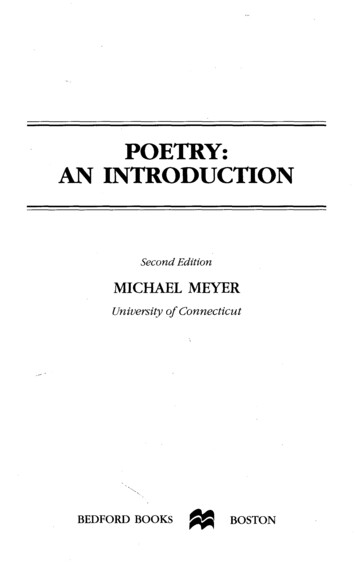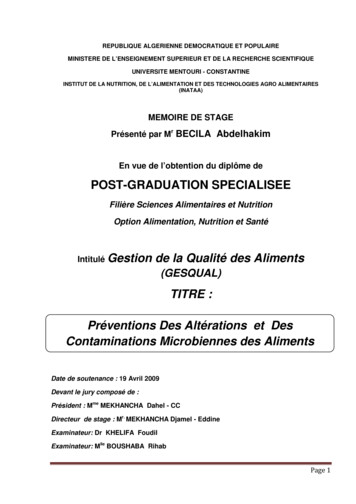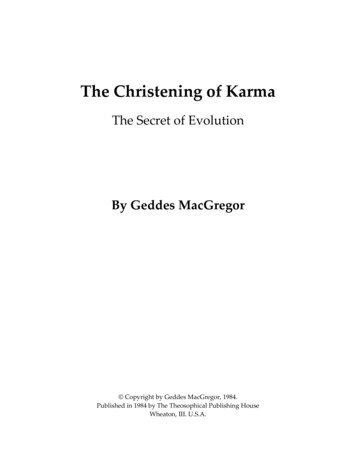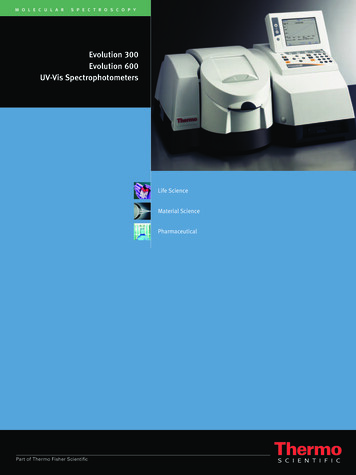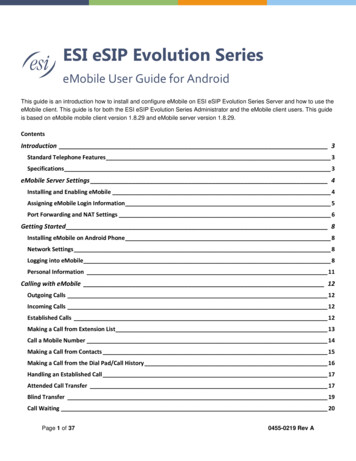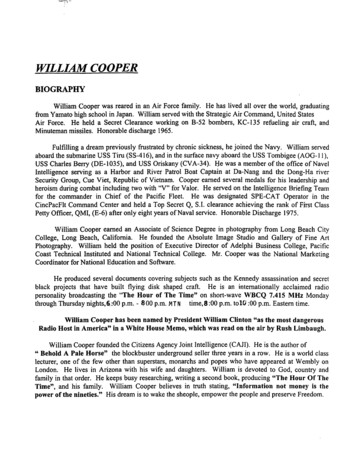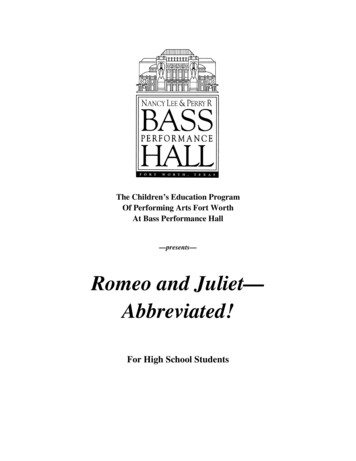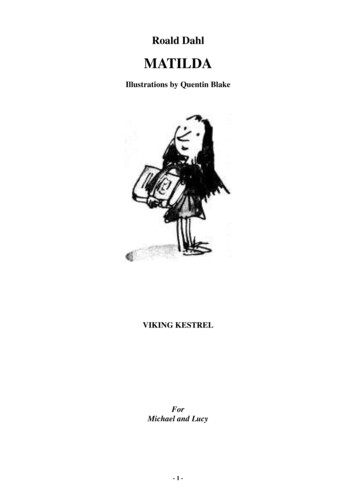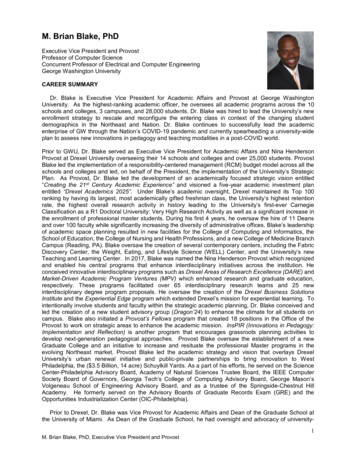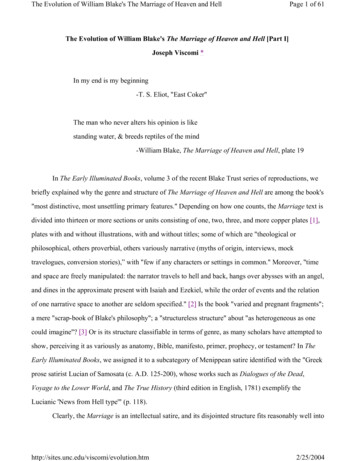
Transcription
The Evolution of William Blake's The Marriage of Heaven and HellPage 1 of 61The Evolution of William Blake's The Marriage of Heaven and Hell [Part I]Joseph Viscomi *In my end is my beginning-T. S. Eliot, "East Coker"The man who never alters his opinion is likestanding water, & breeds reptiles of the mind-William Blake, The Marriage of Heaven and Hell, plate 19In The Early Illuminated Books, volume 3 of the recent Blake Trust series of reproductions, webriefly explained why the genre and structure of The Marriage of Heaven and Hell are among the book's"most distinctive, most unsettling primary features." Depending on how one counts, the Marriage text isdivided into thirteen or more sections or units consisting of one, two, three, and more copper plates [1],plates with and without illustrations, with and without titles; some of which are "theological orphilosophical, others proverbial, others variously narrative (myths of origin, interviews, mocktravelogues, conversion stories),” with "few if any characters or settings in common." Moreover, "timeand space are freely manipulated: the narrator travels to hell and back, hangs over abysses with an angel,and dines in the approximate present with Isaiah and Ezekiel, while the order of events and the relationof one narrative space to another are seldom specified." [2] Is the book "varied and pregnant fragments";a mere "scrap-book of Blake's philosophy"; a "structureless structure" about "as heterogeneous as onecould imagine"? [3] Or is its structure classifiable in terms of genre, as many scholars have attempted toshow, perceiving it as variously as anatomy, Bible, manifesto, primer, prophecy, or testament? In TheEarly Illuminated Books, we assigned it to a subcategory of Menippean satire identified with the "Greekprose satirist Lucian of Samosata (c. A.D. 125-200), whose works such as Dialogues of the Dead,Voyage to the Lower World, and The True History (third edition in English, 1781) exemplify theLucianic 'News from Hell type'" (p. 118).Clearly, the Marriage is an intellectual satire, and its disjointed structure fits reasonably well /2004
The Evolution of William Blake's The Marriage of Heaven and HellPage 2 of 61the Menippean category. Nevertheless, as I argue here, it would be a mistake to infer from thisfit Blake's original intentions for the Marriage—to assume that he set out to write a Menippean satire ormodeled his book on any one specific work. In this essay, the first of a three-part study on the evolutionof the Marriage, I argue that the idea of a disjointed, miscellaneous work entitled The Marriage ofHeaven and Hell emerged only after Blake had written and executed plates 21-24 and planned his "Bibleof Hell," and that the structure of the whole work is in some measure the result of a production history inwhich sections were written and executed at different times.Narrative discontinuity alone suggests that textual units were not composed in the order inwhich they are now read. But it only suggests and does not prove disjointed production, and it does notprovide the clues necessary to establish the sequence in which the textual units were composed.Analysis of the text cannot answer basic questions, such as whether individual units or groups of unitscommitted were committed to copper plates soon after they were written, or only after the entiremanuscript was completed. For clues and for answers, we need to examine technical features unique toilluminated printing; the first printing of plates 21-24; the different lettering styles among the Marriageplates; and, most important, the manner in which plates 21-24 and the other plates were supplied fromlarger sheets of copper. This examination will demonstrate that the four copper plates carrying the textof pages 21-24—which constitute a sustained attack on Swedenborg—were quarters cut from the samesheet of copper, were executed soon after their text was written, and were the first unit produced. Theyappear to have been written and printed (at least once) as an independent (though probably unissued)pamphlet, but became instead the core of what became the Marriage, generating twenty of itssubsequent twenty-three plates. These plates, also quarters of larger sheets, can be reconfigured intotheir original sheets; and the sheets, once sequenced by their lettering styles, confirm the textual units asrevealed by linguistic codes and identify the larger sections or likely printing sessions to which the unitsbelong. Material evidence provided by the bibliographic codes—by which I mean lettering style as wellas reconstructed sheets—establishes the sequence in which the units were most likely written andexecuted. [4]When we read the Marriage units in this sequence—that is, in a chronology of plateproduction—we begin to see visual and verbal connections heretofore obscured, connections /2004
The Evolution of William Blake's The Marriage of Heaven and HellPage 3 of 61illuminate Blake's composing process and the creative logic underlying the book's composition.We can trace the development of key ideas and the relation between unit composition and bookproduction—or, in Blakean parlance, between invention and execution. In this hands-on, workshop styleof composing, in which poet and printer could execute plates upon completing autonomous textual units,Blake could think nonlinearly and behave like an artist: ideas and images of a unit already executedcould direct the subsequent creative process. We begin to see how Blake interacted with his graphicmedium and how such interaction encouraged an ever-evolving (what I have called "organic") mode ofcomposition. Witnessing the Marriage unfold through its production enables us to answer basicquestions about the Marriage's form and Blake's original and final intentions, as well as generalquestions about Blake's mode of composing his texts and books. In short, it enables us to see more ofBlake's mind at workThe second essay in my study of the Marriage substantiates the claim made here that plates 2124 were written and executed before the other units, probably as an independent, anti-Swedenborgianpamphlet. I examine their thematic, aesthetic, and rhetorical coherence and date Blake's interest in anddisillusionment with Swedenborg, placing the latter within the context of other critiques most likelyknown to Blake. I identify the primary Swedenborgian texts that Blake satirizes and examine the majorthemes that figure in and help to generate the subsequent plates and units. The third essay traces thesethemes and texts through the remaining textual units in the order in which the units were produced. Itfocuses on Blake’s allusions to printmaking and their connection to Swedenborg, examining in detail theimage and symbolism of the cave. The last essay reveals, in effect, that the Marriage is a series ofvariations on basic themes first raised in plates 21-24. [5]I. Composition in Illuminated PrintingBlake did not date or sign the Marriage. Until recently, most scholars dated it circa 1790-93. [6]A set of complex allusions to Swedenborg, Blake, and Christ on plate 3 suggests the beginning date. [7]The "June 5 1793" inscription on Our End is Come, an engraving used as a frontispiece in Marriagecopy B, one of the earliest copies printed, suggests the conventional end date. The three-year gestation,the perfunctory mention of Swedenborg on plates 3 and 19, and the vociferous attack on plates 5/2004
The Evolution of William Blake's The Marriage of Heaven and HellPage 4 of 61suggest that Blake broke from Swedenborgianism slowly and cautiously, but this conclusion ismistaken. First, the evidence that the composition of the Marriage continued beyond 1790 is very weak(see Early Illuminated Books, 113-16). The engraved frontispiece, for example, is not printed on a sheetof paper conjunct with the title page, as thought earlier (see Bentley, Blake Books, 287 n. 3). With nodocumentary evidence to prove otherwise, we should accept Blake's implied date of 1790, which isimplied on plate 3 and, more persuasively, penned-in on plate 3 of copy F—color printed in circa 1794(see Early Illuminated Books, 145)—as the end-date. Second, the autographic nature of relief etchingencouraged moving quickly from text to plate (as I will argue below)—or at the very least did notpresent any technical obstacles to composition—making it unlikely that a book of twenty-seven smallplates would have taken three years to produce, a good deal longer than any of the other books Blakewas working on during the same period. The schedule suggested by Blake's professional commitmentsalso supports a 1790 date: the years 1789 and 1790, which saw the first illuminated books, were almostcompletely void of (known) outside commissions for engravings, whereas during 1791-92 Blakeengrave at least seventy plates for book publishers. [8]The hypothesis that the Marriage was in progress for three or more years—and that Blake's feudwith Swedenborg was a slow boil, an ambivalence that developed into hostility—is dubious. In fact, asthe present essay argues, the evidence that the Marriage evolved from Blake's hostile attitude towardSwedenborg is very strong. Nevertheless, while the Marriage almost certainly did not take three years tocompose and execute, neither was it completed overnight; it was in progress for a time, but not in theway, or for as long, as we have thought. As we will see in sections 4 and 5 of this essay, it resulted fromfour or five distinct and recognizably sequential periods of composition, all presumably taking place in1790. But before examining the bibliographical evidence indicating chronology, we need to examinewhat the Marriage as a work-in-progess could mean, and that requires clarifying what we already knowabout Blake's composing and production processes. We need to understand how illuminated printingensured execution a creative role in the invention of text, illustration, and design.The suspicion that Blake wrote the units of Marriage out of order is neither new nor surprising.Narrative discontinuity, as noted, suggests as much to the readers of Blake. Logic alone indicates thatplates 21-24—which explain the grounds of Blake’s attack on Swedenborg—were probably /25/2004
The Evolution of William Blake's The Marriage of Heaven and HellPage 5 of 61before plates 3 and 19, where perfunctory mention of Swedenborg appears to rely on informationalready provided, compositionally speaking. But even those who have seen in Blake's eclectic texts themind of the bricoleur, or a reviser and cobbler of fragments, still imagine him pulling the fragmentstogether conventionally. [9] In this view, the narrative's disjointedness is a matter of Blake's drawing ondisparate discourses and traditions. When one speaks of Blake writing illuminated texts, even a text as“seemingly ad hoc” as the Marriage, [10] one is hard pressed not to envision him writing and rewritingthe entire composition on paper before committing it to copper, because one still imagines Blakeworking as a poet in the manuscript tradition and using illuminated printing subsequently as a mode ofreproduction. It is exceedingly difficult to think outside the letterpress paradigm, to conceive of a modeof printing that did not require a finished text or fair copy before execution began; or of a mode ofexecution in which aesthetic decisions regarding page designs could have an immediate effect on thetext, shaping and directing it. In the letterpress paradigm, one simply assumes that a text is written onpaper and then set in type, that is produced and completed before being reproduced, with labor movingdeterminently—and unidirectionally—from author to compositor. Indeed, authors and compositors werenot collaborators, and endings were not set before beginnings. [11]It is commonplace in Blake studies to assert that illuminated printing united invention andexecution, and to view it as a reaction against the division of labor characteristic of letterpress printing;but, this assertion has remained mostly theoretical and contradictory. Not much thought had been givento how—let alone exactly where in production—invention and execution intersect, except in the personof Blake himself, as author and printer. But the same laborer does not necessarily mean undivided labor;the acts of writing and printing in the creation of an illuminated book were still perceived as occurringseparately. This perception is particularly evident in Ruthven Todd's theory of illuminated printing,which attempts to explain how Blake could have avoided writing directly on plates, that is, backward: hemust have transferred from paper first. Like many before him and since, Todd assumed that Blakeproduced his books on paper before reproducing them in metal; this effected a modeling relationbetween text and plate and, furthermore, required fair copies. These are perfectly reasonableassumptions, given that the illuminated page is a print, which by definition reproduces images made inother media, whether visual or verbal. In fact, only by understanding the reasonableness of 25/2004
The Evolution of William Blake's The Marriage of Heaven and HellPage 6 of 61proposal can one fully appreciate how radically Blake broke with conventional modes ofcomposing and printing by not transferring texts or images. [12]Todd's theory presupposed that Blake’s adaption of the “counterproof,” a method of transferringoutlines that preserves the direction of the original in the print. He proposed that Blake, instead ofrewriting his text in graphite on paper, rewrote it in an acid-resistant ink on leaves coated in gum arabic(otherwise the ink would enter the fibers of the paper). He rewrote text clearly and legibly, exactly as hewished it to appear on plates, on leaves cut specifically to fit their designated plates—or within theoutline of the plates drawn on the leaves—for the plates of an illuminated book are not uniform in sizeor shape. He would then carefully register each leaf or page face down onto its designated plate, passleaf and plate through the press, and soak the pair in water to facilitate the transference of the text—which would then appear backward (“counterproofed”) on the plate and be left standing in relief afterthe plate was etched. . Furthermore, the leaves, taken together, would have constituted a fair copy, butthey would have been destroyed in the process of transference (this, Todd believed, explained theabsence manuscripts for the illuminated books). [13] Producing the leaves in advance in this mannernecessarily divided the manuscripts into pages that corresponded exactly to plates. Hence, Blake wouldhave been able to cast off copy—and thus execute plates in order. And, in advance of production, hewould have known which pages were to be illustrated and the size and position of the illustrations. Hewould thus have known ahead the proportion between text and image per page, even if he had not yetdetermined the illustrations, and have had general mock-ups of pages. What is produced in metal wouldbe, as Gilchrist mistakenly assumed, an "imitation of the original drawing," that is, a "facsimile" of whathad been invented on paper. [14]Todd’s theory breaks down quickly when examined historically and technically. Conventionalmethods of transferring texts in etching and engraving do not work in relief etching, which is why Toddimagined Blake radically adapting one. The method he and Hayer describe, however, is strikinglysimilar to the one invented in 1798 by Alois Senefelder (an actor who did not know reverse writing) foruse in lithography. In Blake’s time, moreover, all engravers were trained in reverse writing. Theevidence shows that Blake drew his illustrations on plates directly, without the assistance of transfers;and when he had sketched an illustration beforehand, he merely redrew it on the plate to fit. The 2/25/2004
The Evolution of William Blake's The Marriage of Heaven and HellPage 7 of 61of Nebuchadnezzar in the second state of Marriage plate 24 (see illus. 3) is a case in point: Whenthe plate was first printed, for Marriage copy K, the vignette had not yet been drawn on it (illus. 1),which meant that Blake had to mask the plate's unetched bottom half during printing (see n. 22 below).Only after printing plate 24, with the three accompanying plates, did Blake decide to continue designingit, at which point he added the vignette of Nebuchadnezzar from his Notebook (illus. 2). Because Blakeredrew this image freehand on the plate, the printed image is the reverse of the drawing (illus. 3).The Notebook drawing has no indication of text and appears not to have been drawn as part of anilluminated-page design. It may have been drawn as part of an emblem series that Blake began circa1789-90 and thus before the writing and execution of plates 21-24. In any event, Nebuchadnezzar wasnot chosen randomly; Swedenborg points specifically to Nebuchadnezzar's dream in Daniel 2: 44 asforetelling the New Church as the last and eternal church, a passage reprinted in the Minutes (p. 130) ofthe first General Conference, which, as I have noted, was attended by Blake. Whether Swedenborgreminded Blake of an earlier drawing of his or generated a new one, Blake continued to invent plate 24and deepen the meaning of his text by responding creatively to his own first prints. If, on the other hand,he was merely reproducing a preexistent design, then plate 24 as first printed would probably haveincluded its vignette, and/or the vignette in the Notebook would probably have had text, or someindication of its placement in the design. Instead of transferring or copying the appearance of a pagealready designed, Blake designed his page while executing it, combining his raw materials—text andimage—for the first time on the plate itself instead of on paper.To assume, then, that Blake counterproofed texts—which preserves the direction of theoriginal—while drawing illustrations directly on the plate—which reverses the original—is to 25/2004
The Evolution of William Blake's The Marriage of Heaven and HellPage 8 of 61not only that he could not write backward but also that he was completely indifferent to therelation of text and illustration that he supposedly had designed on paper and was attempting sofastidiously to reproduce in metal. Rather than complicating the composing process with anachronismsand contradictions, we should assume that Blake treated his texts as he did his illustrations. He did notneed to prepare a fair copy for a compositor any more than he needed to prepare a detailed drawing orpage design for himself. He merely needed to rewrite his texts—however they were first prepared and inwhatever condition—legibly (albeit backward) on the plates, placing word and image at the same time,using the same brushes and pens, the tools of "the Painter and the Poet" (E 692). Thus, Blake probablynever had what he did not need, a fair copy of an illuminated book, let alone a manuscript dividedaccording to its final form on plates; he did not know—or need to know—the length of any of hisilluminated books when he began to etch their plates. In the case of Marriage, where the bibligraphicalevidence indicates that units were executed at different times (see below), Blake presumably ended upwith an assortment of texts written at different times, probably on various sizes and kinds of paper, butnever a fair copy of a completed manuscript. As with his other illuminated books, Blake did not knowthe number of plates the Marriage would be until after it was executed.Blake's technique and tools allowed him to combine the raw materials of text and image on theplate to produce original page designs, as opposed to reproducing or facsimilizing preexistent designs.The amount of text written on a plate, the line breaks, letter size, line spacing, and the size and place ofillustrations were not predetermined by a mock-up of that page; they were aesthetic decisions madeduring production, which ensured the marriage of invention and execution. [15] The technique alsoallowed Blake to begin etching plates as soon as he had completed writing a section or chapter—that is,upon completing an autonomous textual unit, or one that he thought was auto-nomous at the time—should he want to. This unprecedented interplay between graphic execution and textual composition iseasily seen in the structure of Songs of Innocence, Milton, and Jerusalem. The first work consists ofindependent texts whose various lettering styles indicate various plate-making sessions; the second wasprinted circa 1811 in two books but was dated 1804 by Blake and begins with the ambitious predictionthat it will be complete "in 12 Books," indicating that production began long before the text itself wascompleted; and the last work, which was also dated 1804 though not completed until circa 1820, has 2004
The Evolution of William Blake's The Marriage of Heaven and HellPage 9 of 61sets of plate numbers etched in the metal, the result of Blake inserting plates and changing hismind about the book's organization.Being able to execute and design plates before completing a manuscript made it technicallypossible for Blake to think and work outside the letterpress paradigm—if not also to conceive ofproducing a disjointed work like the Marriage. It made it possible for a text to progress throughproduction, with sections produced at different times and out of order. However, if it is credible thatplates 21-24 were the first unit of Marriage written and executed, to describe the production of theseplates as “out of order” seriously confuses the issue, for at the time of production there was no order tobe out of. To assume that an order existed at this time is either to think in terms of completed manuscriptproduction or to imagine Blake beginning the Marriage with only a vague idea of a disjointed,miscellaneous work of which these plates, numbered 21-24 only later, were to become part. Besidesrelegating invention to paper, or the mind, such assumptions raise numerous problems. Why start here?Did Blake think this episode would make a good opening for the Marriage, only to change his mindlater? Not likely; the "Note" announcing the forthcoming "Bible of Hell" at the end of plate 24 functionsrhetorically as a conclusion, exactly as it does in the Marriage as a whole. Announcing a forthcomingwork at the end of a publication is reasonable if the work carrying the announcement is completed, but itis very odd for Blake to have included such an announcement here if he had only vague notion ofwanting to compose a miscellaneous book. He would have had to have had to know not only that thistext was a section of something larger but also that it was the last unit of that still unwritten text. [16]The "Note" contributes to the Swedenborgian satire, in that it calls to mind Swedenborg'sannouncement near the end of True Christian Religion: "Inasmuch as the Lord cannot manifest himselfin Person . . . and yet he foretold that he should come, and establish a New Church, which is the NewJerusalem, it follows, that he will effect this by a Man, who not only can receive the Doctrines of thatChurch in his Understanding, but also publish them in Print." [17] Printing Swedenborg's text was theraison d'etre of the Theosophical Society, founded in 1783 by Robert Hindmarsh and otherSwedenborgians to promote "the Heavenly Doctrines of the New Jerusalem, by translating, printing, andpublishing the Theological Writings of the Honourable Emanuel Swedenborg." [18] The Society wasitself modeled after the Manchester Printing Society, which began in 1782 to print and /25/2004
The Evolution of William Blake's The Marriage of Heaven and HellPage 10 of 61Swedenborg's works in English. The Swedenborgian New Jerusalem Church emerged in January1788 from a splinter group of the Theosophical Society led by Hindmarsh. Publishers, including Blake’sfriend Joseph Johnson, typically announced forthcoming books at the ends of pamphlets, but theSwedenborgian context suggests that Blake had Hindmarsh in mind. [19]Blake's "Note" ends in the middle of the plate, but instead of starting another episode, Blake leftthe space blank, printed it in that state, and then added a vignette, creating a second state of the plate(see below). He is clearly thinking of plates 21-24 as an autonomous unit, but, as will become clear, itwas probably not one of several units he was then planning to write but rather the unintended model forwhat he was to write. Blake's "Note" ends a text that at four plates in length was nonetheless the secondlongest narrative in illuminated printing when it was written in 1790. The longest was The Book of Thel,which, as we will see, appears to have consisted only of plates 2-7, with just five text plates, at that time.At four pages, then, the autonomous text attacking Swedenborg would not have seemed unusually shortfor Blake to print as an independent work. The earliest and only extant independent printing of plates21-24, known as Marriage copy K, strongly supports this hypothesis.II. Marriage copy K: Pamphlet, Proofs, or Incomplete Marriage?Plates 21-24 were printed in black ink on both sides of one conjunct half-sheet with a bottomdeckled edge. [20] The sheet was folded to form a pamphlet with the following configuration: 21/2223/24. These four monochrome prints are not proofs (a correction to the views we expressed in EarlyIlluminated Books, 115; and see Viscomi, Blake and the Idea of the Book, 394 n. 10), despite their inkcolor and uncolored condition and the presence of two first-state plates (21, 24). Plates 22 and 23 wereprinted together as an inside forme and were carefully registered onto the paper and aligned to oneanother by eye. They were printed first, with plates 24 and 21 printed as the outside forme and registeredby eye to plates 23 and 22, so that the lines of text on recto and verso of the leaves roughly align. Therewould have been no reason for Blake to take such pains with his printing if he were merely pullingworking proofs—that is, checking to see if the design is finished or stands sufficiently in relief, or if theprinting pressure is correct—but it is perfectly appropriate for producing illuminated pamphlets m2/25/2004
The Evolution of William Blake's The Marriage of Heaven and HellPage 11 of 61More revealing still, the borders of all four plates were carefully wiped of ink so they would notprint, a practice Blake followed almost without exception when printing illuminated books between1789 and 1795. [21] In preparing intaglio plates for printing, printers wiped clean the beveled edges toensure an aesthetically pleasing platemark (the plate’s embossment into the paper); wiping the bordersof relief plates is an adaptation of this practice—though its effect was the erasure of the tell-tale signs ofgraphic reproduction—because relief plates were printed with less pressure and did not leavepronounced platemarks. This erasure transforms an otherwise overt imposition of metal onto paper intoan image that looks as if it were drawn by hand on the paper, executed spontaneously like sketch andautograph. Printing relief plates to appear like manuscript pages would have been unnecessary if Blake’sintent was merely to proof.Only one other textual unit in the Marriage was printed with this kind of care and attention—andit too was produced as a pamphlet. "A Song of Liberty," which consists of plates 25-27, wasindependently printed at least twice. These printings are referred to as Marriage copies L and M; thelatter is untraced but described in a 1918 Christie's catalogue (see Bentley, Blake Books, 287); theformer is now in the Robert N. Essick Collection (illus. 4). Copy L consists of three uncoloredimpressions that were printed in black ink, with wiped borders, on aconjunct sheet of laid paper folded in half, forming a four-pagepamphlet: 25/26-27. (They are not proofs, but are the only extantilluminated impressions on laid paper [a correction to our statements inEarly Illuminated Books, 115; and Viscomi, Blake and the Idea of theBook, 394 n. 10]). Plates 25 and 26 were carefully registered recto-verso so that their lines are aligned;facing plates 26 and 27 are equidistant from the paper's top edge and the center fold. Plate 25 is in itsfirst state; plate 27 is in a second (and final) state. [22] Though printed separately at least twice, "Song"may not have been issued as a pamphlet—or at least, despite its potential for separate printing and issue,no such copies are extant. The extant and untraced copies both appear to have passed through JohnLinnell's family, which indicates that they remained with Blake until at least 1818, when he met hisyoung patron (see Bentley, Blake Books, 301). Yet, while these two copies were apparently not issued,one cannot infer from the absence of other copies that the “Song” was never issued; by that logic, 2004
The Evolution of William Blake's The Marriage of Heaven and HellPage 12 of 61unique copies of The Book of Los and The Book of Ahania demostrate that those works werenever issued. We can say with reasonable assurance that whatever his original intentions for the "Song,"Blake attached it to the Marriage. These three unillustrated pages of twenty numbered statements and"Chorus" read—and look—like a "coda." As we will see, "Song" was probably written after
Feb 25, 2004 · mind of the bricoleur, or a reviser and cobbler of fragments, still imagine him pulling the fragments together conventionally. [9] In this view, the narrative's disjointedness is a matter of Blake's drawing on disparate discourses and traditions. When one speaks of Blake w

